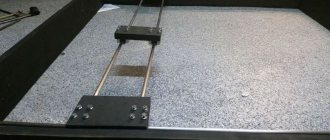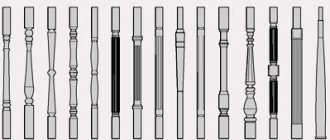An autotransformer is a type of transformer that has one winding on a multilayer core. It is similar to a two-winding transformer, but differs in that part of the winding is common to both the primary and secondary sides. In the load state, part of the current is transmitted directly from the power source, and the remaining part is transmitted from the action of the device itself. Thus, the device acts as a voltage regulator.
Laboratory autotransformer (LATR)
What is a laboratory autotransformer (LATR)
Very often among electricians and electronics engineers the abbreviation LATR . Remember, we once looked at the power supply and even made it ourselves. The power supply gave us a constant voltage from zero to some final value, which, of course, depended on the steepness of the power supply. Agree, a very convenient thing. But there is one drawback - it only gives us constant voltage .
But, since there is a power supply for constant voltage, then there must be a power supply for alternating voltage . And such a power supply is called a laboratory autotransformer , or LATR . What is this thing and what is it eaten with?
LATR is the same transformer. It converts alternating voltage of one magnitude into alternating voltage of another magnitude . But the trick is that we can change the voltage at the LATR output if necessary.
Peculiarities
Considering what LATR is, it should be noted that this is a type of autotransformer. It is characterized by low power and does not require a state register. The operating principle of a laboratory regulating autotransformer is to adjust the AC voltage of a single-phase (on the left in the photo) or three-phase network (on the right).
The LATR circuit includes a toroidal steel core. There is only one contour on it. This device does not have two separate windings. The contours are combined. One part can be classified as coils of the primary type, and the other - as coils of the secondary type. The LATR regulating autotransformer has a fairly simple circuit. The user can independently adjust the number of turns of the secondary winding. This distinguishes the presented type of units from other transformers. We wrote about how to assemble an LATR with your own hands here.
Types of LATRs
Single-phase
This type of LATR produces single-phase alternating regulated voltage. It is very often used by radio amateurs, as it allows you to select any low-voltage alternating voltage.
Three-phase
This type of LATR is used in industrial electronics. A three-phase voltage is supplied to its input, and at the output we get the same three phases, but with a smaller amplitude. This LATR allows you to change the voltage amplitude of all three phases simultaneously . Roughly speaking, these are three single-phase LATRs, which are located in the same housing and which change the voltage equally.
Application area
The features of the autotransformer allow it to be used in everyday life and various areas of industry.
Metallurgical production
Regulated autotransformers in metallurgy are used to check and adjust the protective equipment of rolling mills and transformer substations.
Utilities
Before the advent of automatic stabilizers, these devices were used to ensure the normal operation of televisions and other equipment. They consisted of a winding with a large number of taps and a switch. He switched the output of the coil, and the output voltage was controlled using a voltmeter.
Currently, autotransformers are used in relay voltage stabilizers.
Reference! In three-phase stabilizers, three single-phase autotransformers are installed, and adjustment is made in each phase separately.
Chemical and petroleum industry
In the chemical and petroleum industries, these devices are used to stabilize and regulate chemical reactions.
Production of equipment
In mechanical engineering, such devices are used to start electric motors of machine tools and control the rotation speed of additional drives.
Educational establishments
In schools, technical schools and institutes, LATRs are used to perform laboratory work and demonstrate the laws of electrical engineering, and experiments on electrolysis.
Description of the work of LATRA RESANTA
Let's look at a single-phase LATR manufactured in Latvia RESANTA (read in Russian) brand TDGC2-0.5 kVA.
From above our LATR looks like this:
We see a regulator with which we can set the voltage we need.
On the front side we see some kind of alternating voltage voltmeter. We apply voltage from the 220 V network to the terminals on the left, and from the terminals on the right - the voltage that we currently require.
How LATR works in practice
Let's conduct experiments with a 95 Watt 220 Volt incandescent light bulb. To do this, connect it to the output terminals on the right.
I wonder at what voltage the light bulb filament will start to glow? Let's find out! We turn the regulator until we notice a faint glow of the light bulb.
We look at the regulator scale. 35 Volts!
Did you know that in the USA the mains voltage is 110 Volts? I wonder how our light bulb would glow then? We set it to 110 Volts.
It glows, as they say, at full incandescence.
Now compare how it glows at 220 V
There is no point in increasing the voltage further. The light bulb may burn out.
If you want to set the voltage with great accuracy, then, of course, you can’t do without a multimeter. To do this, set the multimeter knob to the AC voltage measuring position.
We cling and measure the alternating voltage. At the same time, we adjust it using the LATR regulator. Exactly 110 Volts!
Operating rules
The disadvantage of a homemade charger for a 12V battery is that after the battery is fully charged, the device does not automatically turn off. That is why you will have to periodically glance at the scoreboard in order to turn it off in time. Another important nuance is that checking the charger for spark is strictly prohibited.
Additional precautions to take include:
- when connecting the terminals, make sure not to confuse “+” and “-”, otherwise a simple homemade battery charger will fail;
- connection to the terminals should only be made in the off position;
- the multimeter must have a measurement scale greater than 10 A;
- When charging, you should unscrew the plugs on the battery to avoid its explosion due to boiling of the electrolyte.
Master class on creating a more complex model
That, in fact, is all I wanted to tell you about how to properly make a charger for a car battery with your own hands. We hope that the instructions were clear and useful for you, because... This option is one of the simplest types of homemade battery charging!
Also read:
- How to assemble a distribution board
- Connection diagram of a single-phase electric meter to the network
- Why does the RCD trip?
A visual example of the finished product
Master class on creating a more complex model
Safety precautions when working with LATR
I would also like to add a few words about safety precautions. There are LATRs without galvanic isolation . This means that the phase wire from the network goes directly to the output of such a LATR. The LATR circuit without galvanic isolation looks like this:
In this case, a network voltage of 220 Volts may appear at the output terminal of the LATR with a probability of 50/50. It all depends on how you plug the LATR mains plug into a 220 Volt socket.
If you look closely at the circuit diagram on the front panel of the LATR Resanta, you can see that the “X” and “x” terminals (the two bottom ones) are connected to each other by a conductor.
That is, if there is a phase on the “X” terminal, then there will also be a phase on the “x” terminal! You won’t measure the phase in the socket every time to insert the plug correctly, will you? Therefore, BE extremely CAREFUL! Try not to touch the LATR output terminals with your bare hands!
In principle, I touched it and nothing like that happened to me. The problem turned out to be that I have a wooden floor, which is almost a dielectric. I measured the voltage between me and the phase - about 40 Volts came out. That's why I didn't feel these 40 Volts. If I grabbed the battery with one hand or stood with my bare feet on the ground, and with the other hand grabbed the output “x” of the LATR, then I would be shaken very, very hard, since all the full 220 Volts would pass through me.
Device principle
Autotransformers are characterized by a specific device and principle of operation. Their first winding is part of the second circuit or vice versa. Such circuits are characterized by electromagnetic and galvanic coupling. Increasing and decreasing units are used in many areas of human activity. Moreover, its characteristics are determined by the characteristics of the windings.
When connected to an AC coil, a magnetic flux is detected in the core. In each of the existing turns, an electromotive force will be induced at this moment. Moreover, its value will be identical.
The autotransformer diagram explains the operating principle of the unit. When a load is connected, the secondary electrical flow will move through the winding. At this moment, the primary current also moves along the same conductor. Both flows add up geometrically. Therefore, a very small electric current will be supplied to the winding.
Isolation transformer and LATR
There are also safer types of LATRs. They include an isolating transformer . The diagram of such a LATR looks something like this:
As we can see, the phase wire is isolated from the output terminals of such a LATR, thanks to a transformer, the operating principle of which you can read in this article. In this case we may be shaken if we set a high voltage at the output of the LATR using a twister and grab two output wires of the LATR at once. That is, there is a typical galvanic isolation .
Wire calculation
It is not advisable to use an autotransformer for large transformations for the following reasons:
- There is a high risk of receiving currents close to a short circuit. This is compensated by special electronic circuits or additional resistance. For small loads it is more profitable to use an electronic LATR.
- The advantages over transformers are lost: high efficiency, saving on conductor and steel, small dimensions and weight, cost.
We are determining within what limits the LATR will operate. We select 220 V for the network supply. We select 127, 180 and 250 V as secondary voltages. We limit the power to 300 W. You can choose your own values and make similar calculations using the example of this article.
The winding is calculated based on the larger current. The highest current will be when converting a voltage of 220 to 127 V. The autotransformer in this case is a step-down one, and circuit 1 is suitable for it. Based on the provided circuit, we calculate the maximum current I passing in the winding of both circuits:
I = I2 – I1 = P / U2 – P / U1 = 300 / 127 – 300 / 220 = 1 A
- where I, I2, I3 are currents in the corresponding sections of the circuit, A;
- P – power, W;
- U1, U2 – primary and secondary circuit voltages, V.
The wire diameter is calculated using the formula:
d = 0.8 * √I = 1 mm.
From Table 1, select the wire type and cross-section. We make the choice taking into account the calculated current and the average current density for transformers - 2 A/mm².
The LATR transformation coefficient n is calculated using the formula:
n = U1 / U2 = 220 / 127 = 1.73
For further calculation, we calculate the design power Pр:
Pр = P * k * (1 – 1/n) = 300 * 1.2 * (1 – 1/1.73) = 151.92 W
where k is a coefficient that takes into account the efficiency of the autotransformer.
To determine the number of turns per 1 volt, it is necessary to calculate the cross-sectional area of the core S and determine the type of magnetic circuit:
S = √ Pр = √ 151.92 = 12.325 cm²
W0 = m / S = 35 / 12.325 = 2.839
- where W0 is the number of turns per 1 volt;
- m – 50 for rod and 35 for toroidal magnetic cores.
If the steel is not of very high quality, it is worth increasing the W0 value by 20-30%. Also, when calculating turns, their number should be increased by 5-10% to avoid voltage sag. We calculate the number of turns for selected voltages 127, 180, 220 and 250 V:
w = W0 * U
We get 360, 511, 624 and 710 turns.
To calculate the length of the wire, we wrap one turn around the magnetic circuit and measure its length. Then we multiply by the maximum number of turns and add 25-30 centimeters for each terminal to the terminal.











